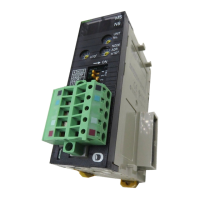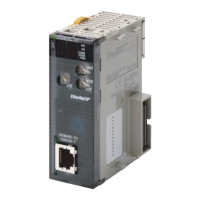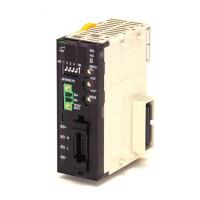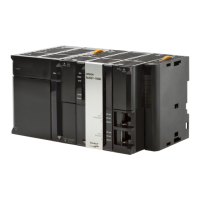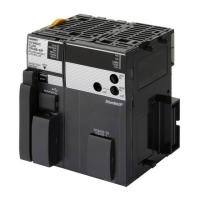88
Specifications Section 2-1
Functions Provided by CJ1M CPU Units Only
Item Specifications Reference
Built-in
I/O
Built-in
inputs
General-pur-
pose inputs
As with Input Units, ordinary input signals are handled
according to the I/O refresh timing, and are reflected in
I/O memory.
Built-in I/O Operation Manual:
5-1-2 General-purpose Inputs
Interrupt
inputs
Interrupt inputs (Direct mode):
Interrupt task numbers 140 to 143 are started at the ris-
ing or falling edge of bits 00 to 03 of CIO 2960.
Response time: 0.3 ms
Interrupt inputs (Counter mode):
Interrupt task numbers 140 to 143 are started by incre-
menting or decrementing counters for bits 00 to 03 of
CIO 2960).
Response frequency: 1 kHz
Built-in I/O Operation Manual:
5-1-3 Interrupt Inputs
High-speed
counters
The signal inputs to the built-in input terminals are
counted. The following four types of high-speed counter
inputs can be used:
Phase-differential pulse inputs:
30 kHz (for open collector) and 50 kHz (for line driver)
Pulse + direction inputs:
60 kHz (for open collector) and 100 kHz (for line driver)
Up/down pulse inputs:
60 kHz (for open collector) and 100 kHz (for line driver)
Increment pulse inputs:
60 kHz (for open collector) and 100 kHz (for line driver)
The interrupt task can be started when the comparison
condition for the count of the high-speed counter is met.
There are two methods of comparison with the PV of
the high-speed counter:
1) Target value comparison
2) Range comparison
It is also possible to prohibit counting input signals
(gate function).
Built-in I/O Operation Manual:
5-1-4High-speed Counter
Inputs
Quick-
response
inputs
Read, as input signals, pulse signals shorter than the
cycle time (minimum pulse width: 50 µs).
Built-in I/O Operation Manual:
5-1-5 Quick-response Inputs
Built-in
outputs
General-pur-
pose outputs
As with Output Units, the contents of I/O memory are
output according to the I/O refresh timing.
Built-in I/O Operation Manual:
5-2-2 General-purpose Out-
puts
Pulse out-
puts
Fixed duty ratio pulse signals (duty ratio: 50%) are out-
put from the built-in output terminal. Speed control
(continuous output of pulses at a specified frequency)
and positioning (output of a specified number of pulses
at a specified frequency, and then stopping) are possi-
ble.
Built-in I/O Operation Manual:
5-2-3 Pulse Outputs
Variable duty
pulse out-
puts
(PWM(891)
outputs)
Execute pulse outputs with a set duty ratio (the ratio of
ON time and OFF time in one pulse cycle).
Built-in I/O Operation Manual:
5-2-4 Variable Duty Ratio Pulse
Outputs (PWM(891) Outputs)
Estab-
lishing
the ori-
gin
Origin
search
Establishes the mechanical origin by pulse outputs
based on a pattern specified in the origin search
parameters.
Built-in I/O Operation Manual:
5-3-2 Origin Search
Origin return Moves to the origin from any position.
Built-in I/O Operation Manual:
5-3-5 Origin Return
Serial PLC Link Uses the built-in RS-232C port to exchange data
among CPU Units with no need for a program. The
Serial PLC Link can also include PTs set for NT Links
(1:N mode) combined with CPU Units.
Programming Manual:
6-4-3 Serial PLC Links

